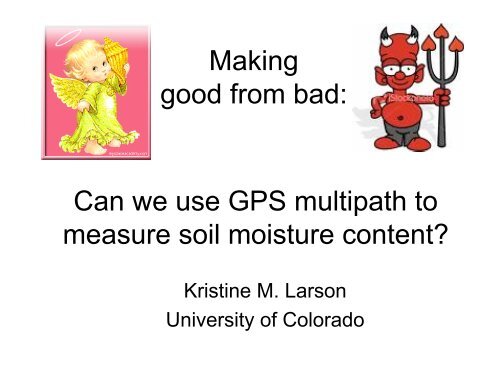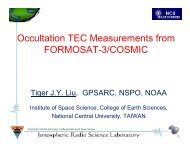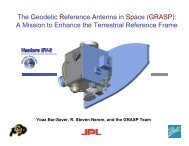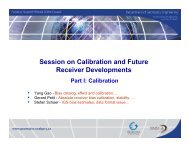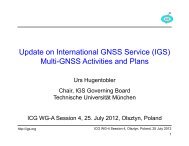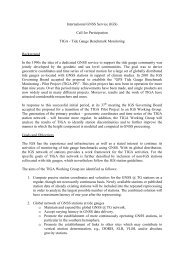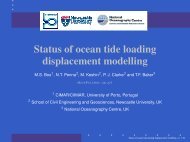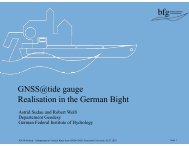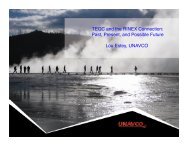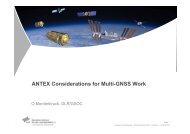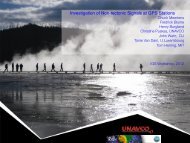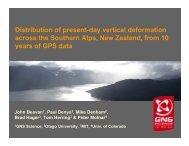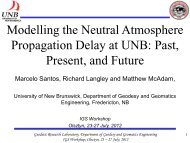Can we use GPS multipath to measure soil moisture content ... - IGS
Can we use GPS multipath to measure soil moisture content ... - IGS
Can we use GPS multipath to measure soil moisture content ... - IGS
You also want an ePaper? Increase the reach of your titles
YUMPU automatically turns print PDFs into web optimized ePapers that Google loves.
Making<br />
good from bad:<br />
<strong>Can</strong> <strong>we</strong> <strong>use</strong> <strong>GPS</strong> <strong>multipath</strong> <strong>to</strong><br />
<strong>measure</strong> <strong>soil</strong> <strong>moisture</strong> <strong>content</strong>?<br />
Kristine M. Larson<br />
University of Colorado
<strong>GPS</strong> Soil<br />
Moisture<br />
Team<br />
Members<br />
John Braun, UCAR<br />
Andria Bilich, NGS<br />
Eric Small, CU<br />
Valery Zavorotny<br />
NOAA<br />
Ethan Gutmann, CU
Outline<br />
• Overview on <strong>soil</strong> <strong>moisture</strong><br />
• <strong>GPS</strong> reflections/<strong>multipath</strong><br />
• Results from Tashkent<br />
• Results from Marshall, Colorado<br />
• Conclusions
Why <strong>measure</strong> <strong>soil</strong> <strong>moisture</strong>?<br />
• Important <strong>measure</strong>ment for climate system studies.<br />
• Needed for improving models and ground truth for<br />
remote sensing studies.<br />
• Current instrumentation is sparse (and data are costly <strong>to</strong><br />
collect).<br />
SCAN
Penetration depth depends on frequency and <strong>soil</strong> <strong>moisture</strong> <strong>content</strong>.<br />
Njoku &<br />
Entekhabi,<br />
1996
It also depends on <strong>soil</strong> type<br />
Silty Clay<br />
Dielectric Constant<br />
Sandy Loam<br />
Moisture Content<br />
Njoku &<br />
Entekhabi,<br />
1996
And Soil <strong>moisture</strong> is highly variable.
<strong>GPS</strong> <strong>multipath</strong> work - the expensive kind
Using geodetic receivers: <strong>we</strong> know what<br />
frequencies are produced by ground <strong>multipath</strong>
And <strong>we</strong> know where the <strong>multipath</strong> reflection point is<br />
Antenna<br />
Elevation<br />
Angle<br />
Multipath amplitude is a function of surface reflectance,<br />
which is related <strong>to</strong> <strong>soil</strong> <strong>moisture</strong> <strong>content</strong>.
How are <strong>we</strong> going <strong>to</strong> quantify <strong>multipath</strong>?<br />
SNR: S1 and S2
SNR data quality<br />
• Source: Bilich, PhD dissertation, 2006;<br />
Bilich et al., Proceedings of the ION,<br />
2007.<br />
• Good SNR data for:<br />
– AOA ACT, L1 and L2<br />
– Trimble NetRS L2 (especially on block IIR-<br />
M)<br />
– Ashtech Z-12 L1
What do <strong>soil</strong> <strong>moisture</strong><br />
<strong>measure</strong>ments typically look like?<br />
160 210 260<br />
day of year<br />
Kurc and Small, 2004
Results for Tashkent<br />
AOA ACT operated by GFZ; 6 meter pillar.<br />
Larson et al., <strong>GPS</strong> Solutions, online 2007
Results for Marshall, Colorado
Fresnel Zone at elevation angle of 10 degrees<br />
Reflection points, 10-30 degrees.
Block IIR-M satellites Fresnel Zones
<strong>GPS</strong> Multipath<br />
Last<br />
Monday<br />
Average of 5 time domain reflec<strong>to</strong>meters.
Summary<br />
• <strong>GPS</strong> <strong>multipath</strong> shows great promise for <strong>soil</strong><br />
<strong>moisture</strong> studies.<br />
• Every antenna type will need <strong>to</strong> be<br />
tested/calibrated (i.e. radomes matter).<br />
• Existing <strong>GPS</strong> receivers/data/monuments can<br />
be <strong>use</strong>d, resulting in an extremely economical<br />
<strong>soil</strong> <strong>moisture</strong> network.<br />
• <strong>GPS</strong> <strong>multipath</strong> senses large <strong>soil</strong> regions (30<br />
by 20 meters), which are of interest <strong>to</strong><br />
hydrologists and atmospheric scientists.
Summary<br />
• Improved resolution of <strong>soil</strong> <strong>moisture</strong> <strong>content</strong><br />
could lead <strong>to</strong> <strong>multipath</strong> corrections for precise<br />
positioning.<br />
• The <strong>IGS</strong> network would be significantly<br />
improved for <strong>multipath</strong> work if online station<br />
pho<strong>to</strong>s <strong>we</strong>re always available.<br />
• SNR data are (relatively) easy <strong>to</strong> <strong>use</strong> - but<br />
limited in their utility by lack of reliability on<br />
the receiver manufacturer side.
Acknowledgements<br />
• NSF EAR and ATM<br />
• <strong>IGS</strong>, UNAVCO, NGS, SOPAC,<br />
CDDIS<br />
• CU seedgrant.<br />
• GFZ, Markus Romatschi<br />
• Penny Axelrad & Jim<br />
Normandeau


